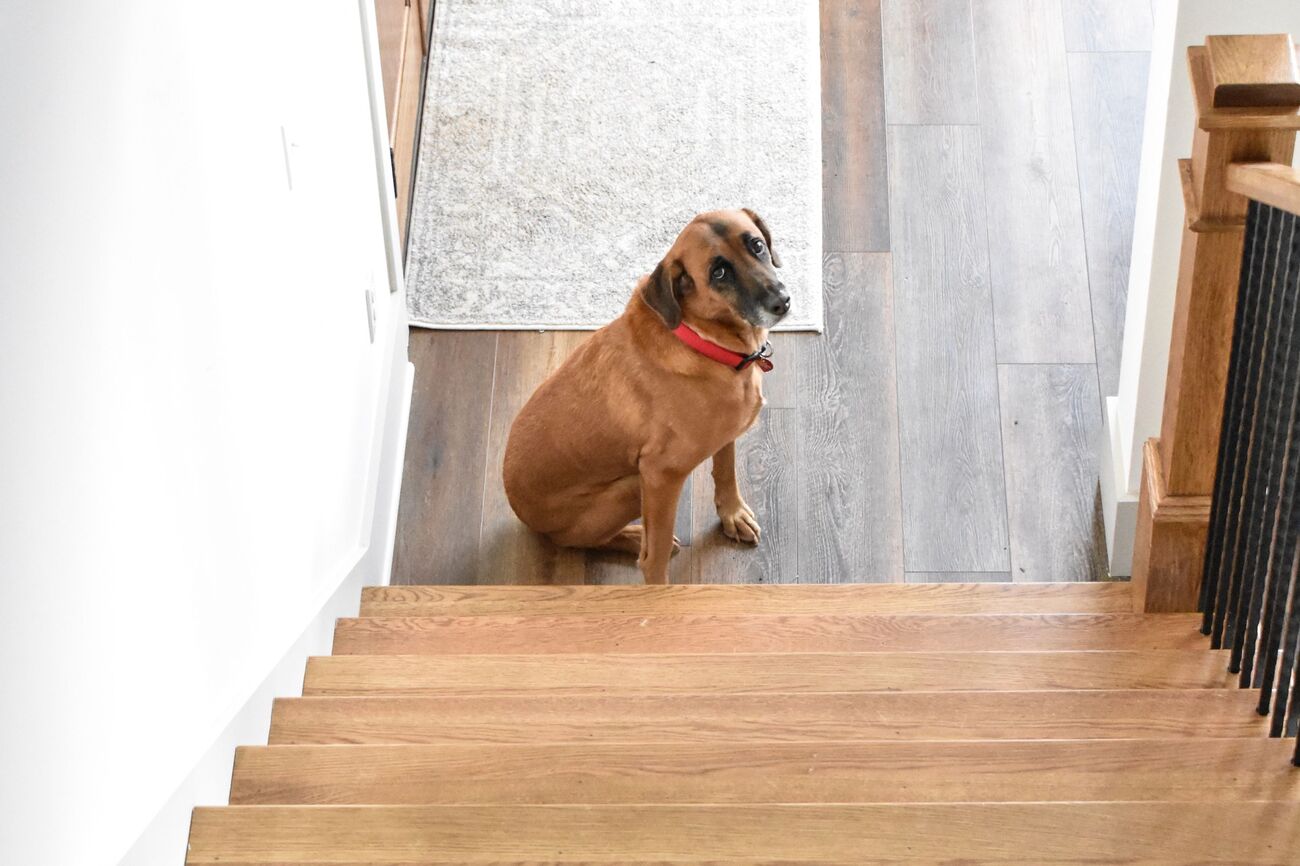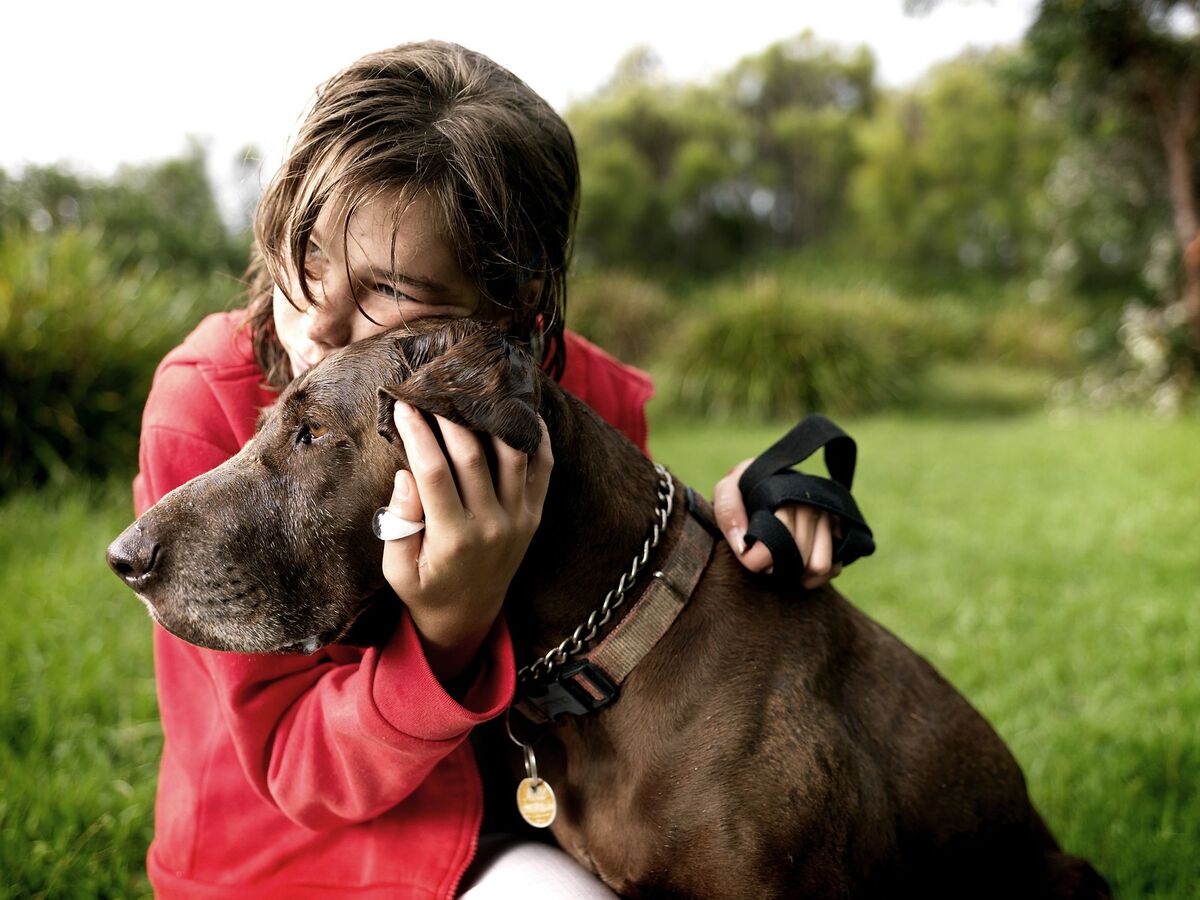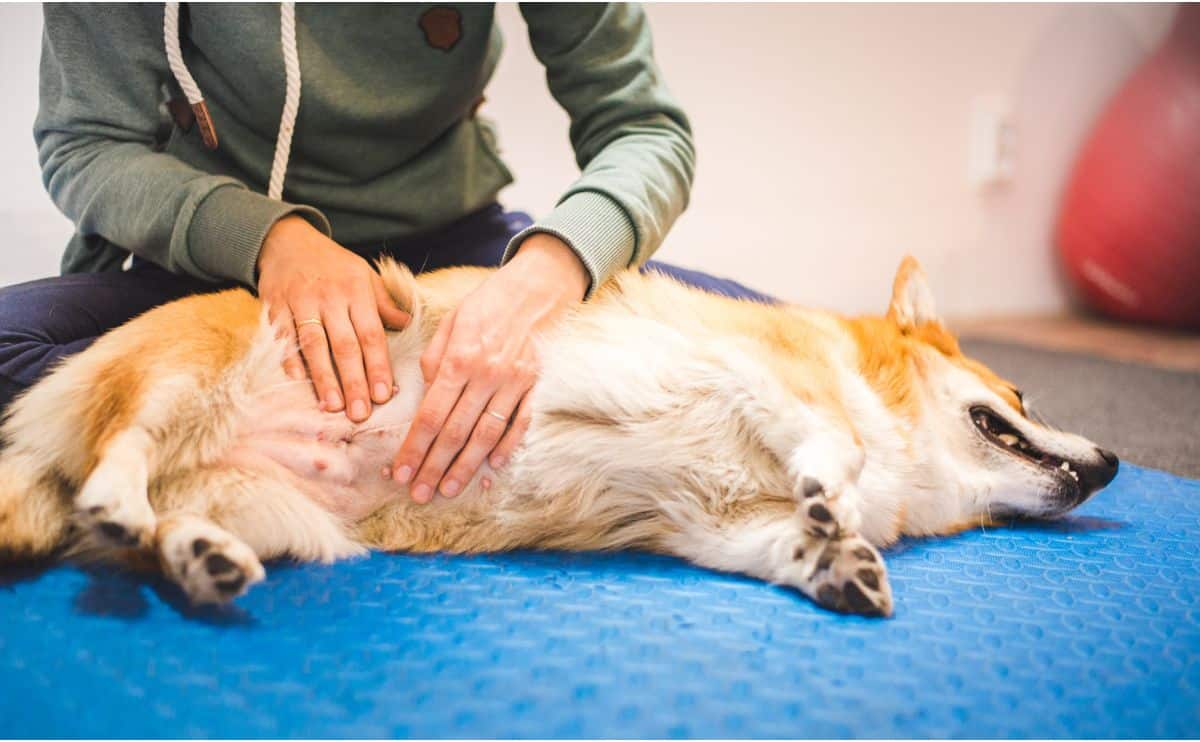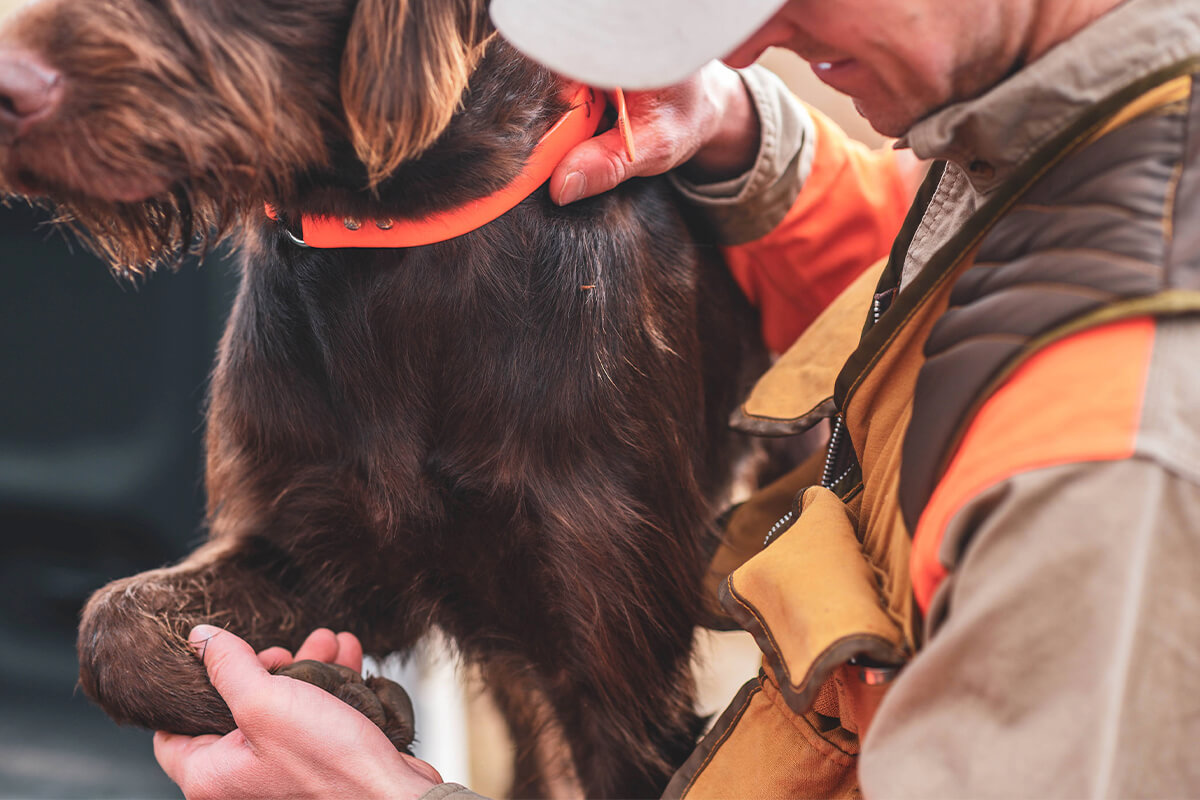Home>Health & Wellness>Common Health Issues>Muscular and Joint Health>How To Get A Dog With Arthritis Up And Down Stairs


Muscular and Joint Health
How To Get A Dog With Arthritis Up And Down Stairs
Modified: February 21, 2024
Learn how to support your dog's muscular and joint health with arthritis, and help them navigate stairs with ease. Expert tips and advice for caring for a dog with arthritis.
(Many of the links in this article redirect to a specific reviewed product. Your purchase of these products through affiliate links helps to generate commission for Pawsomeoldies.com, at no extra cost. Learn more)
Table of Contents
Introduction
Arthritis is a common condition that affects not only humans but also our beloved canine companions. As a pet owner, witnessing your furry friend struggle with mobility issues due to arthritis can be heart-wrenching. One of the challenges that dogs with arthritis often face is navigating stairs. Whether it's ascending to a favorite spot or descending for a walk, stairs can pose a significant obstacle for arthritic dogs. In this article, we will delve into the various aspects of helping a dog with arthritis manage stairs, providing valuable insights and practical tips to ensure their safety and comfort.
Arthritis in dogs can manifest in various forms, including osteoarthritis, rheumatoid arthritis, and degenerative joint disease. These conditions can cause pain, stiffness, and reduced mobility, making everyday activities such as climbing stairs a daunting task for our furry friends. Understanding the impact of arthritis on a dog's joints and overall well-being is crucial in devising effective strategies to support them in their daily routines.
By gaining insights into the challenges faced by dogs with arthritis when it comes to stairs, pet owners can take proactive measures to alleviate discomfort and minimize the risk of injury. From assessing a dog's ability to navigate stairs to implementing supportive measures and exercise regimens, there are numerous ways to enhance their quality of life and ensure they can move around with greater ease and confidence.
In the following sections, we will explore the nuances of arthritis in dogs, delve into the assessment of a dog's ability to manage stairs, and provide practical tips for assisting arthritic dogs in navigating stairs. Additionally, we will discuss the role of exercise and rehabilitation in improving the mobility and overall well-being of dogs with arthritis. By delving into these topics, pet owners can gain valuable insights and actionable guidance to support their furry companions in overcoming the challenges associated with arthritis and stairs.
Read more: When To Put Your Dog Down Due To Arthritis
Understanding Arthritis in Dogs
Arthritis in dogs is a complex and often debilitating condition that affects the joints, leading to pain, stiffness, and reduced mobility. The most common form of arthritis in dogs is osteoarthritis, which occurs when the protective cartilage that cushions the joints begins to deteriorate, resulting in friction and inflammation within the affected joints. This degenerative process can be attributed to various factors, including age, genetics, obesity, joint trauma, and underlying health conditions.
As with humans, arthritis in dogs can significantly impact their quality of life, making it challenging for them to engage in physical activities and perform everyday tasks. The symptoms of arthritis in dogs may manifest subtly at first, with pet owners noticing a gradual decline in their dog's mobility and reluctance to engage in activities they once enjoyed. Over time, the condition can progress, leading to visible signs of discomfort, such as limping, difficulty rising from a resting position, and reluctance to climb stairs or jump onto elevated surfaces.
It's essential for pet owners to recognize the signs of arthritis in their dogs and seek veterinary care to establish an accurate diagnosis and develop a tailored management plan. Through diagnostic procedures such as physical examinations, X-rays, and joint fluid analysis, veterinarians can assess the extent of joint damage and formulate an appropriate treatment approach.
In addition to osteoarthritis, dogs can also be affected by other forms of arthritis, including rheumatoid arthritis and degenerative joint disease. Rheumatoid arthritis is an autoimmune condition that causes the immune system to attack the body's own tissues, including the joints, leading to inflammation and joint damage. Degenerative joint disease, on the other hand, involves the gradual deterioration of joint cartilage and the formation of bone spurs, resulting in pain and restricted movement.
Understanding the underlying mechanisms of arthritis in dogs is crucial for pet owners, as it enables them to empathize with their furry companions and take proactive measures to alleviate their discomfort. By gaining insights into the complexities of arthritis and its impact on a dog's joints, pet owners can cultivate a deeper understanding of their dog's needs and provide the necessary support to enhance their overall well-being.
In the subsequent sections, we will delve into the assessment of a dog's ability to manage stairs and provide practical tips for assisting arthritic dogs in navigating this common obstacle. Additionally, we will explore the role of exercise and rehabilitation in improving the mobility and quality of life of dogs with arthritis, offering valuable guidance for pet owners seeking to optimize their dog's comfort and mobility.
Assessing Your Dog's Ability to Navigate Stairs
Assessing a dog's ability to navigate stairs is a crucial step in understanding the challenges they may face due to arthritis. It involves observing their mobility, comfort level, and any signs of difficulty or discomfort when encountering stairs. As a pet owner, being attuned to your dog's behavior and physical capabilities can provide valuable insights into their specific needs and help you tailor supportive measures accordingly.
When assessing your dog's ability to manage stairs, consider the following aspects:
1. Mobility and Comfort
Observe how your dog approaches stairs and moves up or down. Note any hesitancy, reluctance, or signs of discomfort, such as limping, favoring certain limbs, or vocalizing distress. Dogs with arthritis may exhibit stiffness or reluctance to engage in activities that require joint movement, which can be particularly evident when navigating stairs.
2. Balance and Stability
Assess your dog's balance and stability when ascending or descending stairs. Look for any signs of unsteadiness, loss of coordination, or difficulty maintaining a steady gait. Arthritic dogs may struggle to maintain their balance due to joint pain and reduced mobility, leading to potential challenges when navigating stairs.
Read more: How Long Do Arthritis Flare-Ups Last In Dogs
3. Speed and Agility
Take note of your dog's speed and agility when navigating stairs. Arthritic dogs may move more slowly, cautiously, or with hesitancy, as they seek to minimize discomfort and avoid exacerbating joint pain. Pay attention to any alterations in their typical movement patterns and agility when encountering stairs.
4. Behavioral Cues
Observe your dog's behavioral cues and body language when approaching stairs. Signs of anxiety, reluctance, or avoidance may indicate that stairs pose a significant challenge for them. Additionally, monitor their response to assistance or supportive measures, as this can provide insights into their comfort level and potential areas of difficulty.
By carefully assessing your dog's ability to navigate stairs, you can gain a deeper understanding of the specific challenges they face due to arthritis. This understanding forms the foundation for implementing targeted strategies to support and assist them in overcoming these challenges, ultimately enhancing their comfort and mobility.
In the subsequent sections, we will delve into practical tips for helping arthritic dogs manage stairs, as well as explore the role of exercise and rehabilitation in improving their overall well-being and mobility. These insights will equip pet owners with actionable guidance to enhance the quality of life for their furry companions, ensuring they can navigate stairs with greater ease and confidence.
Tips for Helping Your Dog Up and Down Stairs
Assisting an arthritic dog in navigating stairs requires thoughtful consideration and proactive measures to ensure their safety and comfort. By implementing supportive strategies and making necessary adjustments, pet owners can significantly alleviate the challenges their furry companions face when encountering stairs. Here are practical tips for helping your dog up and down stairs:
-
Provide Adequate Traction: Enhance the traction on the stairs by using non-slip stair treads or adhesive strips. This helps prevent slipping and provides your dog with a secure footing, reducing the risk of falls or discomfort.
-
Use a Ramp or Lift: Consider installing a ramp or lift alongside the stairs to provide an alternative, less strenuous means of movement for your dog. Ramps offer a gradual incline, making it easier for arthritic dogs to ascend and descend without exerting excessive pressure on their joints.
-
Assistive Devices: Explore the use of assistive devices such as harnesses or slings designed specifically for supporting dogs with mobility challenges. These devices can provide stability and aid in lifting your dog gently when navigating stairs.
-
Gentle Encouragement: Offer gentle encouragement and positive reinforcement as your dog approaches the stairs. Use soothing verbal cues and gestures to reassure them, creating a supportive and reassuring environment that encourages them to navigate the stairs with greater confidence.
-
Manage Weight Distribution: When assisting your dog on the stairs, ensure that their weight is evenly distributed to minimize strain on specific joints. Support them as needed, distributing their weight evenly to reduce discomfort and potential exacerbation of arthritis symptoms.
-
Create a Comfortable Environment: Keep the stair area well-lit and free from obstacles to facilitate safe and stress-free navigation for your dog. A well-lit and unobstructed pathway can enhance their confidence and reduce anxiety when encountering stairs.
-
Consider Joint Supplements: Consult with your veterinarian about the potential benefits of joint supplements for your arthritic dog. These supplements can support joint health and mobility, potentially easing their discomfort and enhancing their ability to navigate stairs more comfortably.
-
Regular Monitoring and Adjustments: Continuously monitor your dog's response to navigating stairs and make necessary adjustments based on their comfort level and any changes in mobility. Being attentive to their needs allows for proactive modifications to support their evolving requirements.
By implementing these tips, pet owners can create a supportive and accommodating environment for their arthritic dogs, enabling them to navigate stairs with greater ease and reduced discomfort. These measures contribute to enhancing their overall well-being and quality of life, ensuring that they can move around their environment with confidence and comfort.
Exercise and Rehabilitation for Dogs with Arthritis
Exercise and rehabilitation play a pivotal role in managing arthritis in dogs, offering a multifaceted approach to improve their mobility, alleviate discomfort, and enhance their overall well-being. When tailored to the specific needs of arthritic dogs, exercise and rehabilitation regimens can contribute significantly to their joint health, muscle strength, and flexibility, ultimately enabling them to navigate stairs and engage in daily activities with greater ease.
Read more: How Dogs Get Arthritis
Low-Impact Exercise
Low-impact exercises are particularly beneficial for dogs with arthritis, as they minimize stress on the joints while promoting muscle conditioning and cardiovascular health. Activities such as swimming, gentle walks, and controlled movements tailored to the individual dog's capabilities can help maintain joint flexibility and prevent muscle atrophy. Swimming, in particular, offers a non-weight-bearing form of exercise that allows dogs to engage in physical activity without subjecting their joints to excessive strain. This can be especially advantageous for arthritic dogs, as it provides a full-body workout while minimizing impact on the affected joints.
Physical Therapy
Physical therapy techniques, including massage, passive range of motion exercises, and hydrotherapy, can be instrumental in improving a dog's mobility and comfort. Massage therapy helps alleviate muscle tension, improve circulation, and reduce pain, contributing to enhanced mobility and overall comfort. Passive range of motion exercises, performed under the guidance of a veterinary professional, help maintain joint flexibility and prevent stiffness. Hydrotherapy, which involves exercises in water, provides buoyancy and resistance, promoting muscle strength and joint mobility while minimizing impact on arthritic joints.
Weight Management
Maintaining a healthy weight is crucial for dogs with arthritis, as excess body weight places additional strain on their joints, exacerbating discomfort and reducing mobility. A tailored nutrition plan, in consultation with a veterinarian, can help manage a dog's weight and support joint health. By achieving and maintaining an optimal body condition, arthritic dogs can experience reduced joint stress, improved mobility, and enhanced overall well-being, making it easier for them to navigate stairs and engage in physical activities.
Rehabilitation Aids
Utilizing rehabilitation aids such as orthopedic beds, supportive braces, and therapeutic heating pads can provide comfort and alleviate joint pain for arthritic dogs. Orthopedic beds offer cushioning and support for achy joints, promoting restful sleep and overall comfort. Supportive braces can stabilize and support arthritic joints, reducing discomfort and enhancing mobility. Therapeutic heating pads can help soothe sore muscles and joints, providing relief from arthritis-related pain and stiffness.
By incorporating these exercise and rehabilitation strategies into a comprehensive management plan, pet owners can significantly improve the quality of life for their arthritic dogs. These tailored approaches address the specific needs of arthritic dogs, promoting joint health, muscle strength, and overall comfort, ultimately enabling them to navigate stairs and engage in daily activities with greater ease and confidence. Through a holistic approach that encompasses low-impact exercise, physical therapy, weight management, and rehabilitation aids, pet owners can empower their arthritic dogs to lead fulfilling and comfortable lives, free from the limitations imposed by arthritis.
Read more: How Do Dogs Get Septic Arthritis
Conclusion
In conclusion, supporting a dog with arthritis in navigating stairs requires a multifaceted approach that encompasses understanding the impact of arthritis, assessing their mobility, and implementing practical strategies to enhance their comfort and safety. Arthritis in dogs can significantly impede their ability to navigate stairs, leading to discomfort and potential injury. By gaining insights into the challenges faced by arthritic dogs and implementing targeted measures, pet owners can significantly improve their furry companions' quality of life and mobility.
Assessing a dog's ability to manage stairs involves observing their mobility, balance, and behavioral cues, providing valuable insights into the specific challenges they face. By carefully evaluating these factors, pet owners can tailor supportive measures to alleviate discomfort and enhance their dog's confidence when encountering stairs.
Practical tips for helping arthritic dogs up and down stairs include providing adequate traction, using assistive devices, and creating a comfortable environment that promotes safe and stress-free navigation. These measures contribute to enhancing their overall well-being and quality of life, ensuring that they can move around their environment with confidence and comfort.
Furthermore, exercise and rehabilitation play a pivotal role in managing arthritis in dogs, offering a multifaceted approach to improve their mobility, alleviate discomfort, and enhance their overall well-being. Low-impact exercises, physical therapy, weight management, and rehabilitation aids are instrumental in promoting joint health, muscle strength, and overall comfort, ultimately enabling arthritic dogs to navigate stairs and engage in daily activities with greater ease and confidence.
By incorporating these insights and strategies into their daily routines, pet owners can empower their arthritic dogs to lead fulfilling and comfortable lives, free from the limitations imposed by arthritis. It is essential for pet owners to work closely with veterinarians to develop tailored management plans that address their dog's specific needs, ensuring that they receive the necessary support and care to navigate stairs and move around with comfort and confidence.
In essence, by understanding the nuances of arthritis in dogs, assessing their ability to manage stairs, and implementing supportive measures and exercise regimens, pet owners can significantly enhance the well-being and mobility of their arthritic dogs, fostering a nurturing environment that enables them to navigate stairs and engage in daily activities with greater ease and comfort.












